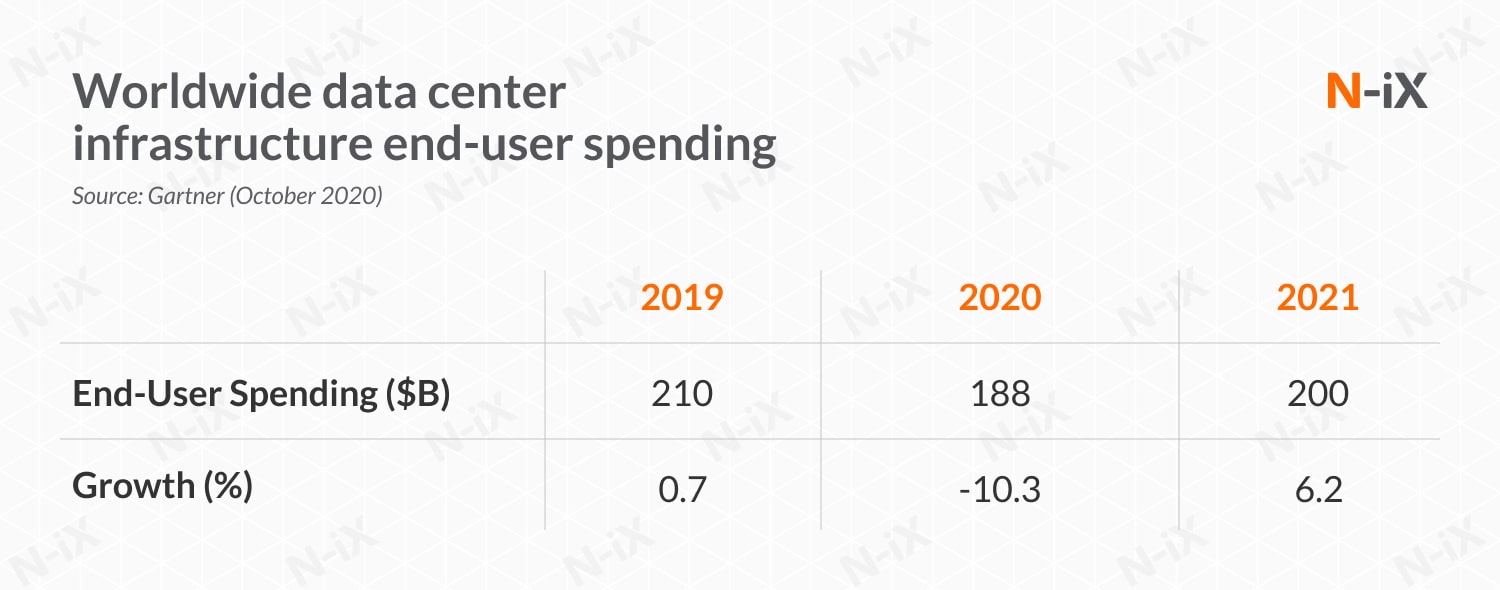Data center migration is now a priority for many organizations. Coronavirus pandemic has only reinforced the importance of data center transformation. Today, businesses undertake different types of data center modernization to ensure business continuity, build resilience, save costs, and gain new efficiencies.
Modern data center infrastructures have evolved from on-premises physical servers to virtualized infrastructure that supports applications and workloads across multiple cloud environments. Data center migration to the cloud is one of the most in-demand types of transformation. Also, it is one of the most challenging approaches to data center transformation, which involves a lot of risks and requires rigorous planning and profound expertise.
So how to plan data center migration? What are key data center migration challenges? And how to solve them? Let’s find out.
Data center migration: stats, types, benefits
Data center migration involves moving a part or the entire IT infrastructure from the existing data center to another, either physically or virtually (cloud). According to the recent study from Gartner, Inc., global spending on data center infrastructure is projected to reach $200B in 2021, an increase of 6% from 2020.
This growth is largely driven by cloud provider investment in data centers. According to the data from Synergy Research Group, the total number of large data centers operated by hyperscale providers increased to 597 at the end of 2020. And over 70% of all hyperscale data centers are located in facilities that are leased from data center operators or are owned by partners of the hyperscale operators.

While cloud provider spending jumps, enterprise investment in on-premise data centers declines. In particular, in the third consecutive quarter of 2020, enterprise spending on their own data center infrastructure dropped 8% from last year. This doesn’t mean that the days of traditional data centers are going to fade. Enterprise data centers will continue to exist and thrive, but their purpose will change. They need to be transformed to deliver cloud solutions to satisfy the needs of fast-growing digital businesses.
The previous year brought a shift in data center transformation, making the majority of large-scale companies reimagine their approach to data center modernization. As a result, companies began increasingly moving their data centers to the cloud. According to the Flexera 2020 State of the Cloud report, 59% of enterprises and 50% of small- and medium-sized businesses (SMBs) have slightly or significantly increased their cloud usage due to the global pandemic. A lot of companies have chosen this type of data center modernization because it gives the greatest benefits. However, it also involves a number of data center migration challenges, which companies have never faced before. Thus, some companies may find it advantageous to try other approaches to data center migration before rushing into moving to the cloud:
- Optimization of existing data centers: the process of reducing the number of physical data centers by simply using fewer servers (migrating the data and apps from one data center to another while closing down underutilized data centers).
- Use of blade servers: the process of substituting existing servers with alternative blade servers (aka high-density servers) to save money and increase efficiencies.
- Data center colocation: the practice of housing privately-owned servers and networking equipment in a third-party data center. Gartner predicts that 80% of enterprises will have shut down their traditional data centers by 2025 - either migrating workloads to colocation data centers or to the public cloud.
- Edged data centers: according to the study by IDC, by 2023, more than 50% of new enterprise IT infrastructure will be allocated to edge environments. Most data we create will be processed at the edge, near the point where it is produced for collection and analysis. By incorporating edge computing with centralized cloud computing, companies can maximize the results.
- Virtualization: the process of creating a modern data center that is highly scalable, available and secure with the help of existing physical servers. A standard data center facility can be used to host multiple virtualized data centers. An example of a virtualized data center is Hyperconverged infrastructure (HCI). It virtualizes all the elements of traditional “hardware-defined” systems (compute, storage, and network resources) offering increased agility, scalability, and simplicity while keeping operational costs down. In other words, HCI ensures cloud-like infrastructure on-premises. Also, with HCI, you can easily extend to public cloud or opt for hybrid cloud.
- Hybrid: this is one of the most common approaches to data center consolidation many businesses adopt. It combines all of the above types of data center migrations. Most organizations are hybrid with various cloud platforms and services (IaaS, PaaS, SaaS), owned and operated data centers, and colocation facilities.
Organizations are increasingly transforming their data centers despite all of the data center migration challenges out there. And here is why:
- support innovation and deliver new applications to market faster;
- reduce costs;
- improve scalability to enter new markets;
- meet evolving security requirements;
- consolidate data centers of two or more different companies as a result of M&A (Merger & Acquisition) activities, etc.
Top 5 data center migration challenges

-
Unwanted downtime
App outages is one of the major concerns for businesses that migrate data centers. Unplanned downtime may impact customer loyalty and cost companies thousands of dollars. To avoid apps downtime during the migration, companies should migrate apps and data in phases, always have a rollback plan, use specialist tools, etc.
-
Data loss
Before the migration, it is vital to make sure that all your data is backed up, especially the files that you'll be migrating. During the migration process, you may encounter such issues as corrupt, incomplete, or missing files. And if you have a backup, you’ll be able to easily correct any errors by restoring the data in its original state.
-
Added latency
Latency is one of the most underestimated data center migration challenges. It can occur when you access applications, databases, and services in the cloud. Latency is especially critical for IoT devices, e-commerce websites, video streaming solutions, and cloud gaming platforms, where customer experience is crucial. If you have applications that require immediate responses, delay in a few seconds can pose serious damage to your business. It can not only lead to frustration and disappointment but also impact your brand reputation. You need to localize and optimize the network, segment traffic flows, establish multicloud connectivity, offload the Internet at the edge, etc. to avoid unwanted latency.
-
Wasted costs
Companies that fail to figure out what they need usually waste their costs because they don’t fully use the possibilities they have and pay for the resources they don’t use in fact. To optimize your costs, you need to adopt DevOps best practices. Assess what resources you are using, analyze what areas can be optimized and how to do it, monitor spending of IT costs, and investigate new services that will help you reduce costs and optimize your infrastructure usage even more.
-
Security
Moving data and apps to a new data center involves a lot of security risks: compliance violations, contractual breaches, insecure APIs, issues on the provider’s side, misconfigured servers, malware, external attacks, accidental errors, insider threats, etc. Experienced DevOps engineers and a security team can make necessary configurations and ensure the long-term security of your data and apps in the new destination.
How to plan for a successful data center migration?

It all starts with finding the right specialists, who will help you navigate through data center migration challenges. If you are looking to take advantage of the cloud, follow these guidelines to ensure successful data center modernization.
- Gather a team of skilled experts: you need to find reliable specialists with solid expertise in cloud migration, DevOps, cloud security, data science, BI, QA, etc. Building such a team in-house is very challenging. You need to find the right people, retain them, take care of all HR, administrative, and infrastructure processes, etc. When you transfer all this to a reliable partner, you can concentrate on more high-value tasks. As the difference between local teams and offshore experts is barely visible now, outsourcing is getting even more attractive. Given the current situation brought by the global pandemic, many companies are increasingly looking for reliable technology partners nearshore or offshore to make the most of their investment in data center transformation.
- Settle on the strategy: To choose the best approach to data center migration, you need to assess the size and type of your data, evaluate the apps you have, figure out interdependent parts, etc.
- Create a plan: it is important to shape business requirements, estimate TCO and the profitability you will gain in the short term and in the long run. Also, you need to outline your goals, timelines, services and technology to use, etc. You need to have a complete picture of the migration process and a backlog of tasks to start with.
- Choose the provider(s): Companies tend to choose the cloud vendor(s) out of the Big 3: AWS, Azure, and GCP. The choice of the vendor(s) depends on many factors. The most important are: client's business needs, budget, technologies or solutions the client is already using. Major cloud vendors such as AWS, Azure, GCP, offer comprehensive tools for online/offline data center migration. You need to compare cloud providers side-by-side to see all the pros and cons and understand whether they have tools and services to help you tackle key data center migration challenges.
- Plan for security: adopt DevSecOps approach, make necessary configurations, train others on how to maintain security.
- Prepare your architecture: the processes of adopting and transforming architecture based on the chosen strategy and target cloud provider’s compatibilities. For example, you can transform your monolith architecture into a number of loosely coupled services.
- Adopt best DevOps practices: CI/CD, rolling updates and IaC.
- Migrate step-by-step: choose the right migration window and check the network bandwidth. First, begin with migrating your data and then move your apps and services starting from low-priority to high-priority solutions.
- Monitor and optimize: apply metrics and KPIs defined on the planning stage to see the benefits. Maintain and improve your achievements to gain better outcomes.
How can N-iX help you resolve your data center migration challenges?
You may find it difficult to tackle challenges in data center migration on your own due to the complexity and tediousness of the process. With N-iX, you will migrate your apps and data to cloud faster, more efficiently, and risk-free.
- N-iX boasts an internal pool of 1,900+ experts.
- N-iX is trusted in the global tech market: the company has been listed among the top software development providers by Clutch, in the Global Outsourcing 100 by IAOP for 5 consecutive years, recognized by GSA UK 2019 Awards, included in top software development companies by GoodFirms.co, and others.
- N-iX partners with leading global companies such as Currencycloud, Lebara, Gogo, Vable, etc. to help them resolve data center migration challenges and take their businesses to the next level.
- N-iX is a Select AWS Consulting Partner, a Microsoft Gold Certified Partner, a Google Cloud Partner.
- We have profound cloud expertise and employ 300+ cloud engineers. Our cloud experts are certified by industry leaders.
- Our expertise in cloud computing includes cloud-native services, on-premise-to-cloud migration, cloud-to-cloud migration as well as multicloud cloud management.
- We offer professional DevOps services, including Cloud adoption (infrastructure set up, migration, optimization), building and streamlining CI/CD processes, security issues detection/prevention (DDOS & intrusion), firewall-as-a-service, and more.
- N-iX has broad data expertise to design different kinds of data solutions: Big Data / Data Warehouse / Data Lake development, Business Intelligence, Data Science, Artificial Intelligence & Machine Learning, etc.
- N-iX has been named No. 72 on the 2020 CRN Fast Growth 150 List for the substantial growth and performance over the previous two years.
- N-iX is compliant with ISO 9001, ISO 27001, PCI DSS, and GDPR standards.
Have a question?
Speak to an expert



